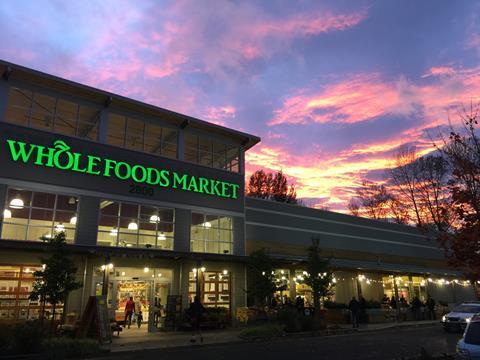
Following the vote by Whole Foods shareholders in favour of Amazon’s US$13.7bn offer for the retail chain, Planet Retail’s Retail Insights Director Natalie Berg considers three key areas in which the takeover will likely have a major impact on the companies’ respective operations.
1) Whole Foods Market branding to be significantly reduced or disappear altogether once Amazon establishes trust and credibility in its fresh food offering.
This isn’t going to happen overnight. Right now Amazon needs Whole Foods for a number of reasons: strength in perishables, brand equity, overlap in customer base, not to mention bricks and mortar presence. But Amazon’s current grocery offering – think AmazonFresh, Prime Pantry, Subscribe & Save, Prime Now – is convoluted and ripe for consolidation.
In the future, if Amazon is truly going to make its mark in grocery, it will need one cohesive message both online and in store. This must be centered around Prime, which has become the gateway to Amazon’s most sought after services – including those with incremental fees such as the above.
2) Amazon will democratise online grocery.
I wasn’t entirely shocked by an acquisition to boost Amazon’s grocery and bricks-and-mortar presence. In fact, last month I wrote that they wouldn’t have a meaningful impact on the grocery sector for at least another 5 years without acquiring someone. What did surprise me was that they chose a supermarket with such niche, premium appeal.
Now you can rightfully argue that this makes sense given 1) overlap with Prime shoppers; 2) targeted demographic with high propensity to buy online; 3) a differentiated offering in the crowded grocery sector is no bad thing.
However, Amazon wants to be everything to everyone and is in the desirable position of being just about the only retailer in the world that can get away with this. They clearly see a need to broaden their customer base, which has been recently evidenced by the acceptance of food stamps plus the launch of Amazon Cash and a pay-monthly Prime membership option.
They may be pigeonholing themselves right now by focusing on premium groceries but I suspect we will see lower prices – both online and in store – and the introduction of more price-sensitive brands in the future.
Expect to see Whole Foods’ private label ranges to gain greater visibility online and across Amazon’s various devices – 365 Dash buttons and own-label recommendations via Alexa are quick wins here. I imagine Amazon will push Wickedly Prime and Amazon Elements in Whole Foods Market stores, but I suspect the remaining brands they have been experimenting with will quietly disappear.
3) Whole Foods stores may see entire categories disappear.
As other analysts have rightfully pointed out, there is no point maintaining the status quo. I suspect stores will:
• First and foremost become more tech-driven/automated. From class dunce to valedictorian, in John Mackey’s own words.
• Feature mini showrooms for Amazon devices to drive its broader ecosystem.
• Act as a collection and returns point for online orders – hugeopportunity, this is why the acquisition is not just about grocery. As evidenced by this week’s launch of Prime Wardrobe, Amazon is preparing itself for a higher rate of returns (until it can eventually predict and send exactly what shoppers want, that is). An in-store returns service would drive traffic to supermarkets while providing shoppers with additional choice.
• Strongly encourage shoppers to become Prime members through special perks and exclusive discounts. Could we see Prime-only checkouts or vip collection points? Although unlikely, we also can’t rule out a tiered pricing model similar to Amazon’s physical bookstores. There would have to be zero price disparity on the essentials – shoppers would vote with their feet otherwise - but perhaps Prime members would have access to exclusive promotions in more discretionary categories.
• Longer-term, I suspect we’ll see some pretty major category shifts. A physical store presence means Amazon can finally move into pharmaceuticals. Five to ten years from now, I can absolutely see certain functional, routine-driven purchases – think toilet paper, pet food, cleaning products – move almost entirely out of the store as Amazon looks to make auto-replenishment a reality, freeing up stores to focus on fresh food, meals for tonight and value-added services.
For more on the acquisition, check out our Planet Retail RNG webinar and of course please feel free to share your thoughts in the comments area below or under my original LinkedIn post.



